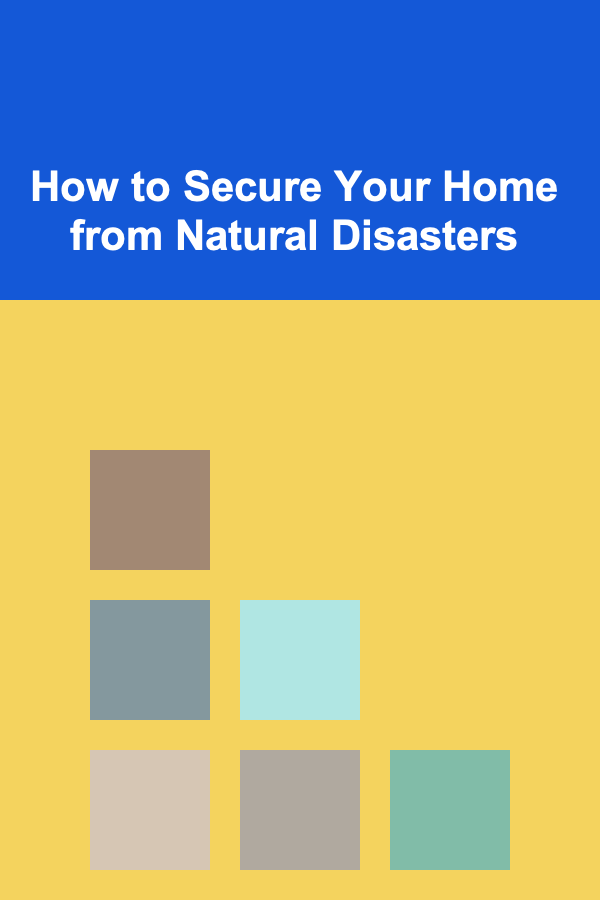
How to Use a Checklist to Prevent Insect Health Problems
ebook include PDF & Audio bundle (Micro Guide)
$12.99$7.99
Limited Time Offer! Order within the next:

Insects, whether they are pests, vectors of disease, or just a general nuisance, are an ongoing concern for human health. These tiny creatures can cause a variety of health problems, ranging from mild allergic reactions to serious diseases such as malaria, dengue, and Lyme disease. Insects also contribute to the transmission of pathogens that affect food crops, leading to foodborne illnesses, and can even be a source of environmental damage. For this reason, preventing insect-related health problems is crucial to maintaining both individual and community well-being.
One effective way to manage and mitigate the risks associated with insects is through the use of a checklist system. A well-designed checklist can help individuals, households, businesses, and even entire communities monitor and address insect-related health risks in a systematic and proactive way. This article will explore the reasons why insects pose health threats, the role of checklists in mitigating these threats, and how to design and use an effective checklist for preventing insect health problems.
Why Are Insects a Health Concern?
1. Disease Transmission
Many insects, especially mosquitoes, ticks, and flies, are known vectors for a wide range of diseases. These insects carry pathogens such as bacteria, viruses, and protozoa, which they transmit to humans and animals through bites or contact. Common insect-borne diseases include:
- Malaria: Transmitted by Anopheles mosquitoes, malaria causes severe fever, chills, and even death if untreated.
- Dengue Fever: Spread by Aedes mosquitoes, dengue can lead to high fever, severe headaches, pain behind the eyes, and joint pain.
- Lyme Disease: Spread by ticks, Lyme disease causes symptoms like fever, fatigue, and a characteristic bull's-eye rash.
- Zika Virus: Transmitted by Aedes mosquitoes, Zika virus has been linked to birth defects, particularly microcephaly in babies born to infected mothers.
2. Allergies and Asthma
Insects, such as cockroaches and dust mites, can exacerbate allergies and trigger asthma attacks. Cockroach allergens are known to worsen asthma symptoms, especially in children, while dust mites, which are technically arachnids, are also associated with indoor allergies. The presence of these insects in the home can lead to long-term health problems, particularly in vulnerable populations such as young children, the elderly, and those with preexisting respiratory conditions.
3. Foodborne Illnesses
Flies and other insects that come into contact with food can act as carriers of harmful bacteria, including Salmonella, E. coli, and Listeria. These bacteria can cause foodborne illnesses, leading to symptoms such as vomiting, diarrhea, and abdominal pain. Insects are particularly problematic in environments where food is prepared or stored, such as kitchens, restaurants, and food processing plants.
4. Environmental Damage
Insects can also indirectly impact human health by destroying crops and causing other environmental damage. Agricultural pests, such as locusts, aphids, and certain beetles, can devastate food supplies, leading to shortages and malnutrition. In some cases, the loss of crops can result in economic hardship and food insecurity, which can further exacerbate public health issues.
The Role of Checklists in Preventing Insect Health Problems
A checklist is a simple yet powerful tool that can help individuals, families, and businesses stay organized and consistent in their efforts to prevent insect-related health problems. By breaking down the tasks required to minimize insect exposure into manageable steps, a checklist makes it easier to ensure that all necessary actions are taken. Furthermore, checklists allow for regular review and tracking, ensuring that preventive measures are sustained over time.
Here are the key benefits of using a checklist to prevent insect-related health problems:
1. Systematic Approach
A checklist helps you tackle insect prevention in an organized and structured way. Instead of trying to remember every little task, you can follow a clear list of actionable items. This ensures that nothing is overlooked and that all potential sources of insect health risks are addressed.
2. Improved Consistency
Insect prevention is not a one-time task but an ongoing process. By using a checklist, you can ensure that preventive actions are regularly performed, maintaining a consistent level of protection against insect-borne health risks.
3. Easy Monitoring and Tracking
A checklist allows you to track your progress over time, ensuring that all preventive measures are being followed. This makes it easier to identify areas where additional action is needed and gives you a record of what has been done, helping you to stay on top of insect prevention tasks.
4. Customizable to Specific Needs
Checklists can be tailored to suit different environments and needs. For example, the checklist for preventing insect health problems in a home will differ from that for a business or agricultural setting. This customization ensures that you can address specific risks in a way that is most effective for your situation.
How to Design an Effective Checklist for Preventing Insect Health Problems
Designing a checklist for insect health problem prevention requires careful consideration of the environment, the types of insects you're trying to control, and the health risks you want to mitigate. Below, we will break down the key components of an effective insect prevention checklist for both residential and commercial settings.
1. Identify Insect Types and Risks
The first step in designing your checklist is identifying the types of insects that pose a health risk in your environment. Different insects require different control measures, so knowing which ones are most common or dangerous in your area is essential.
- Mosquitoes: Focus on controlling breeding grounds, especially standing water.
- Ticks: Focus on vegetation and areas where animals frequent, as they are primary tick hosts.
- Flies: Address waste disposal, food handling, and cleanliness in food preparation areas.
- Cockroaches and Ants: Focus on cleanliness and eliminating food sources in kitchens and other food storage areas.
By understanding the specific insects you're dealing with, you can create more targeted and effective preventive actions.
2. Categorize Preventive Actions
A good checklist should divide actions into categories that are easy to follow. These categories might include:
- Preventive Measures : These are actions that can stop insects from entering or thriving in a given environment.
- Example: Seal cracks in windows and doors to prevent pests from entering.
- Example: Remove standing water to prevent mosquito breeding.
- Elimination Measures : Actions that directly address the presence of insects.
- Example: Use insect traps for cockroaches and ants.
- Example: Apply insecticide to outdoor areas or potential breeding sites.
- Maintenance and Monitoring : Regular tasks to keep insects at bay.
- Example: Check for signs of infestation weekly.
- Example: Change out fly traps or insect repellent as needed.
3. Prioritize Tasks Based on Urgency
While all items on your checklist are important, some tasks may need to be prioritized based on the immediate risk they pose. For example, preventing mosquito breeding is crucial during the rainy season, while keeping food preparation areas free from flies might be more urgent in the summer months. Prioritize high-risk tasks to reduce immediate threats to health.
4. Regular Reviews and Updates
Insect prevention is not a one-time task, and your checklist should reflect that. Schedule regular reviews of your checklist to ensure that preventive actions are still relevant and effective. Additionally, update your checklist as new insects or risks emerge, or as local conditions change.
Example of a Residential Insect Health Prevention Checklist
Preventive Actions:
- Seal cracks and gaps in doors and windows.
- Install or repair window and door screens.
- Keep gutters clean to prevent standing water.
- Store food in sealed containers to avoid attracting insects.
Elimination Actions:
- Use traps for cockroaches, ants, and flies.
- Apply insecticide or natural repellents in areas of high insect activity.
- Set up mosquito nets around sleeping areas in areas with high mosquito populations.
Maintenance Actions:
- Check and replace traps regularly.
- Inspect for signs of insect activity (e.g., droppings, nests).
- Remove standing water regularly to eliminate mosquito breeding sites.
- Keep trash bins tightly sealed and dispose of waste frequently.
Example of a Commercial Insect Health Prevention Checklist
Preventive Actions:
- Install air curtains at entryways to prevent flies and other pests.
- Keep storage areas dry and free from food spillage.
- Ensure all food preparation areas are sanitized regularly.
Elimination Actions:
- Use fly lights or traps in food preparation and storage areas.
- Apply insecticides in accordance with food safety regulations.
Maintenance Actions:
- Inspect traps and light devices weekly.
- Schedule regular pest control services.
Conclusion
Insects are a significant threat to public health, but with the right preventive measures, these risks can be effectively managed. A well-designed checklist is a valuable tool for systematically preventing insect-related health problems. Whether you're dealing with disease vectors like mosquitoes and ticks or allergens like cockroaches and dust mites, a thorough and organized checklist ensures that you remain vigilant in reducing insect exposure. By taking proactive steps and staying consistent, you can protect yourself, your family, and your community from the health dangers posed by insects.
Reading More From Our Other Websites
- [Personal Care Tips 101] How to Pick the Best Toothbrush for Your Teeth's Enamel
- [Home Rental Property 101] How to Find Apartments with a Balcony in Your Next Rental Property
- [Home Maintenance 101] How to Tackle Minor Siding Repair and Replacement Yourself: Saving Money and Protecting Your Home
- [Home Lighting 101] How to Incorporate Color-Changing Lights into Your Home Decor
- [Personal Care Tips 101] How to Choose the Best Concealer for Under-Eye Puffiness
- [Home Family Activity 101] How to Use Family Stories to Teach History and Values
- [Organization Tip 101] How to Store Paints and Inks Without the Mess
- [Home Holiday Decoration 101] How to Decorate a Holiday Tree with a Specific Theme
- [Organization Tip 101] How to Organize Emergency Kits for Home-Based Businesses
- [Survival Kit 101] How to Maintain a Survival Kit for Year‑Round Use in Variable Climates

How to Secure Your Home from Natural Disasters
Read More
How to Set Up a Recycling System for Your Home
Read More
Mastering Game Development: Advanced Strategies for Designing and Launching Popular Games
Read More
How To Engage Your Audience from Start to Finish
Read More
Mastering Video Transcoding: A Comprehensive Guide
Read More
How to Express Opinions and Emotions Clearly
Read MoreOther Products

How to Secure Your Home from Natural Disasters
Read More
How to Set Up a Recycling System for Your Home
Read More
Mastering Game Development: Advanced Strategies for Designing and Launching Popular Games
Read More
How To Engage Your Audience from Start to Finish
Read More
Mastering Video Transcoding: A Comprehensive Guide
Read More